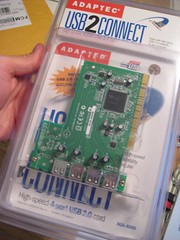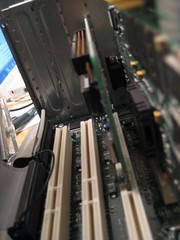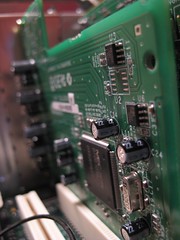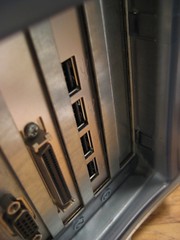Two days and about $15 later, my “Yikes!” PowerMac G4 now features full USB 2.0 capabilities thanks to the PCI card I installed on Thursday.
I shopped on eBay for a few weeks, waiting for the perfect USB PCI card to hit the auctions. One, a PCI card featuring four USB slots, a gigabit Ethernet port, and an extra Firewire 400 port, would have been my choice, but I lost the auction. The one I did buy, a generic Adaptec model, suited my needs find, however. So $9.99 on a “Buy It Now” and $5 for shipping, and my card was on its way.
The model I bought came with a driver CD for most Windows versions and “Mac OS 9.0.4 and above” including Beige G3s. Funny thing, though: the USB card was made when OS X didn’t yet support USB 2.0 speeds:
How about that? An OS 9 driver for a OS X 10.3 Panther machine? Would it still work?
First, though, I had to install the card. It’s an easy enough project on any PowerMac model since the Blue and White G3: simply pull the side lever, open the case up, and locate the PCI slots:
The screws that hold the cover in place are on the “top,” looking down. Unscrew the screw, take off the cover, and pop the PCI slot into place:
Whala – nice and snug.
Snap the cover back in place, plug the monitor, keyboard, Ethernet, and power cord back in place, and fire it up. After I signed in, I reset the PowerMac just to make sure it recognized the new hardware. After it started up again, I signed in and inserted the driver CD.
Notice anything funny about that icon? It’s a low-res, OS 9 icon. Double-clicking on it fired up Classic mode, and the driver installation process had that Platinum look of yesteryear.
The installer dropped the driver into the correct hard drive, and gave me a confirmation notice. From all appearances, everything was finished. I reset the PowerMac one more time, logged on, and tested the USB slots. Sure enough, they worked just fine (even though, to me, I had to insert my flash drive upside down).
Part of me wonders whether the whole driver installation was necessary. Would Panther have recognized the PCI card without the driver? Based on a previous experience trying to install a printer driver on 10.2 Jaguar through Classic – a useless process – the need for a Classic environment was probably a waste. Whatever. The darned thing works.
The PowerMac recognized the higher-speed USB card, as seen here in System Profiler.
Next up, I would like to install a DVD drive in place (or perhaps below) the current CD-ROM drive. Since there are two hard drives on the PowerMac (one the stock 10 GB, and the other an 80 GB add-on), I want to try installing Tiger on the 80 GB drive – perhaps even mirroring my iBook G4 somehow. Playing around with Panther has been fun, and I would hate to lose it completely, so it can remain on the smaller drive. By installing Tiger on the bigger hard drive, I could make the PowerMac a real workhorse machine, complete with my entire iTunes and iPhoto libraries, and the ability to sync my iPod and iPhone.
Also, a processor upgrade would be fun, too – but that seems a bit beyond my reach right now.
The higher-speed USB 2.0 slots bring the PowerMac closer and closer to an everyday machine. Stay tuned for more projects and upgrades on this “Yikes!” model.







I installed a similar USB 2.0 (belkin) in my G4 sawtooth a while back while using 10.3 and didn’t bother with the drivers, it worked right away. Until I got my intel Mac, that USB card provided the ports for my iPhone, Digi Cam and external HDD’s.
Posted by VInce LoGreco on August 13th, 2008.
Good to hear. I plan on using mine the same way – mainly to run my external hard drive, but also for iPod stuff. Thanks Vince!
Posted by davelawrence8 on August 13th, 2008.
your welcome
Posted by VInce LoGreco on August 14th, 2008.